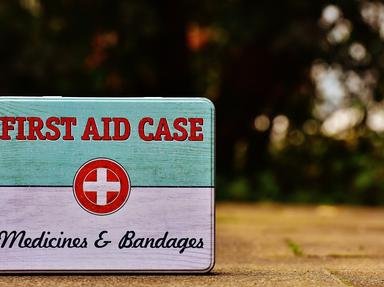Quiz Answer Key and Fun Facts
1. Advanced Life Support (ALS) is often concerned with the cardiac arrest and the peri-arrest time frames, and the Advanced Cardiac Life Support (ACLS) is no exception. Both ALS and ACLS can deal with Acute Coronary Syndromes (ACS). Which of the following is NOT considered to be an Acute Coronary Syndrome (ACS)?
2. As an EMT or Paramedic, you are examining a patient whom you suspect of suffering with an Acute Coronary Syndrome (ACS). Which of the following treatment regimes is perhaps ill-advised for the pre-hospital care provider?
3. Thrombolytic therapy has been shown to provide a substantial reduction in mortality from Acute Myocardial Infarction (AMI) when administered in the first few hours after the onset of pain or discomfort. Which of the following would contraindicate the administration of thrombolytic therapy to a patient with an AMI?
4. Heart rhythms associated with cardiac arrest generally fall into two categories - Shockable, and Non-Shockable. Shockable rhythms are those in which defibrillation should be attempted. Which of the following are shockable rhythms?
5. Reversible causes of cardiac arrest should be considered during treatment. In an effort to make these easier to remember, they may be divided into two groups, known as the 4Hs and the 4Ts.
Which of the following best represents the 4Ts?
6. It is not uncommon, especially in the pre-hospital setting, to have a cardiac monitor that enables monitoring on 'modified limb leads' I, II, and III. This requires placement of only 3 leads - and in Australia, these leads are often coloured red, white, and black.
What is the correct placement for these leads to monitor leads I, II, and III?
7. Access to the circulation is required during CPR in order to give drugs and fluids, to take blood samples, and in some settings for transvenous pacing, and intravenous access is the most reliable for giving drugs during resuscitation. The EMT / Paramedic must decide on accessing a central vein or a peripheral vein in order to achieve venous access to the circulation. Which of the following best indicates circulation time (from infusion site, through the heart, down to the femoral artery) for each of these choices?
8. Drugs are often used in the peri-arrest patient as well as those who advance to cardiac arrest. Which of the following drugs is listed in the amount used in the cardiac arrest situation rather than the peri-arrest situation?
9. Advanced Life Support (ALS) treatment of peri-arrest arrhythmias involves consideration of several treatment options, including vagal manoeuvres, drug therapy, and electrical cardioversion. Electrical cardioversion is relatively reliable at restoring sinus rhythm by terminating a tachyarrhythmia, however, cardioversion must be synchronised with a particular part of the ECG. Which part of the ECG should shock deliver coincide with?
10. In many cases involving out-of-hospital cardiac arrest, a close friend or loved one will have performed CPR on the patient, and the needs of this person or people are often overlooked in the ongoing care and treatment of the patient. Which of the following has NOT been recognised by loved ones as an advantage to being present during resuscitation efforts?
Source: Author
ecnalubma
This quiz was reviewed by FunTrivia editor
crisw before going online.
Any errors found in FunTrivia content are routinely corrected through our feedback system.
